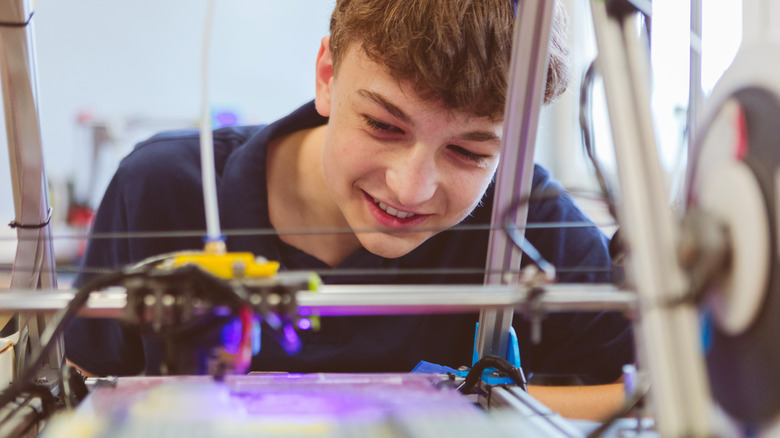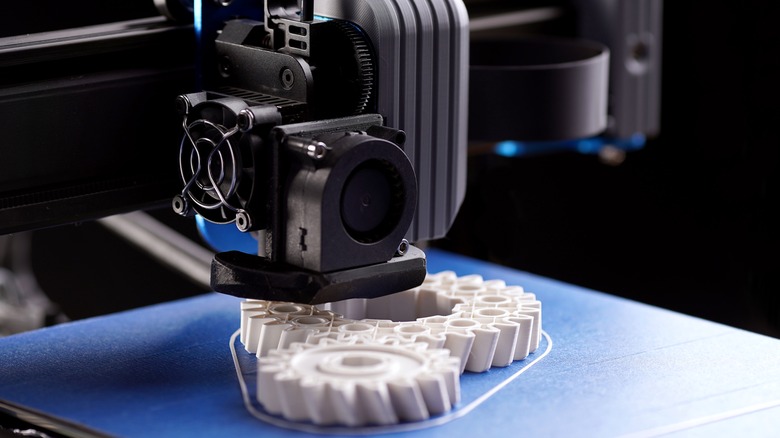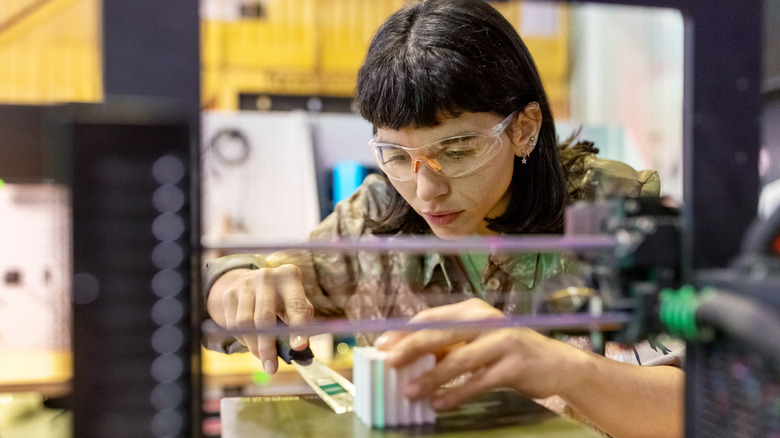
Izusek/Getty Images
Of course, 3D printers aren’t solely for hobbyists and/or those looking to make a suit of armor for their cats. On a professional level, the scale of the projects that can be completed through 3D printing technology is truly staggering, particularly when employed by accomplished users. For instance, through fused deposition modeling, sections of aircraft wall can be 3D printed. According to Stratview Research (via PR Newswire), aerospace’s 3D printing market share is set to reach $6.7 billion by 2027.
Most 3D printer users, however, probably aren’t making airplanes in their own homes. Smaller-scale practical applications, such as creating tools, can make them appealing to many owners. They may appreciate not only the raw potential of the devices from a creative standpoint, but the potential health concerns that scientists have discussed too.
Let’s take a look at an introduction to how exactly 3D printers work, the plastics involved in the process, and the conclusions that scientists have recently drawn about the potential health implications of such particulates.
How 3D printers work and some factors to be wary of

R_Boe/Shutterstock
The 3D printing process is incredible to behold for newcomers to the technology. Some of the most common forms of 3D printing include stereolithography, fused deposition modeling, and Digital Light Processing. The specifics differ widely between the methods. In SLA, for instance, an ultraviolet laser and ultraviolet oven are used in sequence to form and then treat the resin materials. DLP printers are considerably faster because they heat the surface to melt it instead, saving a step.
Whichever form of 3D printing is being used, though, the process boils down to one specific act: the melting and reshaping of plastics. Temperatures of around 220°C are typically used for this purpose with PLA filaments, which means that operators must take care while using their printers to avoid any potential burn risks.
An April 2017 3D printer safety report from Concordia University notes that another primary safety concern to bear in mind with 3D printers is that of the chemicals emitted by the process: «Studies on thermal processing of plastic show that industrial extrusion equipment emit[s] hazardous substances. Even at moderately high temperature (e.g., 170-240°C), gaseous substances are emitted during thermal processing of thermoplastic.»
The proliferation of microplastics is a matter of global concern, but what impact can the emissions of 3D printers potentially have on our health? Next, we’ll see what the latest research has to say on the matter.
Scientific research on the potential dangers of 3D printer emissions

Supersizer/Getty Images
Melissa Finnegan et al’s December 2023 study, «Characterization of Volatile and Particulate Emissions from Desktop 3D Printers,» is the latest attempt to illuminate the matter. The authors note that 3D printing is becoming increasingly popular, in both home and dedicated professional settings, and set about determining the process’s suitability for such environments. To do so, they created what they deemed a «homemade printing chamber» from two storage containers, housing an FDM 3D printer, a Creality Ender-3, within it.
«Gas chromatography/mass spectrometry was employed to profile VOC (volatile organic compounds) emissions, while a particle analyzer was used to quantify and characterize particulate emissions,» the study explains. A simple cube of 20mm each side was printed over 26 minutes, using eight ABS filaments and eight PLA ones. After each use, SPME fibers were added to the machine for 15 minutes before being extracted. A WIBS (Wideband Integrated Bioaerosol Sensor), meanwhile, measured particles emitted while the printer was in use.
«In general, the total VOC emissions are greater for ABS compared with PLA,» the report concluded, but results varied a lot from filament to filament. The colors of them, and so the additives used, can potentially make a difference, but generally, the irritants acetophenone and Benzaldehyde are among the VOCs found when the results were examined, as was caprolactam, described as «an irritant … associated with ocular and respiratory toxicity.» The latter, along with Lactide, was «reasonably uniform in terms of recovered abundances.»
3D printing safety

Alvarez/Getty Images
«Characterization of Volatile and Particulate Emissions from Desktop 3D Printers» does not, of course, claim that certain filaments will always produce specific amounts of specific VOCs, because environmental factors, printer model and settings, and other variables will affect these things.
What is plain is that the process of 3D printing can produce potentially harmful emissions such as styrene, which the researchers discovered to be among «the three highest emitters.» This is corroborated by Parham Azimi et al’s January 2016 study, «Emissions of Ultrafine Particles and Volatile Organic Compounds from Commercially Available Desktop Three-Dimensional Printers with Multiple Filaments.» This earlier work found styrene to be among the most-emitted VOCs from polystyrene and acrylonitrile butadiene styrene filaments.
In October 2022, Forbes quoted Vice President and Senior Technical and Strategic Advisor at Chemical Insights Research Institute of Underwriters Laboratories, Marilyn Black, as stating that such emissions are «similar to air pollution released by vehicular exhaust … this pollution is associated with lung and heart disease or cardiopulmonary disease.»
The long-term impact of 3D printing on human health is a topic that still holds many mysteries. The priority is not to be scared away from using the devices, but rather to use them responsibly. Melissa Finnegan et al’s study emphasizes that industrial 3D printer usage has strict guidelines, and imitating these in the home environment, through careful ventilation and selection of materials used, can go a long way. We can’t all have robots operating our 3D printers for us, after all.